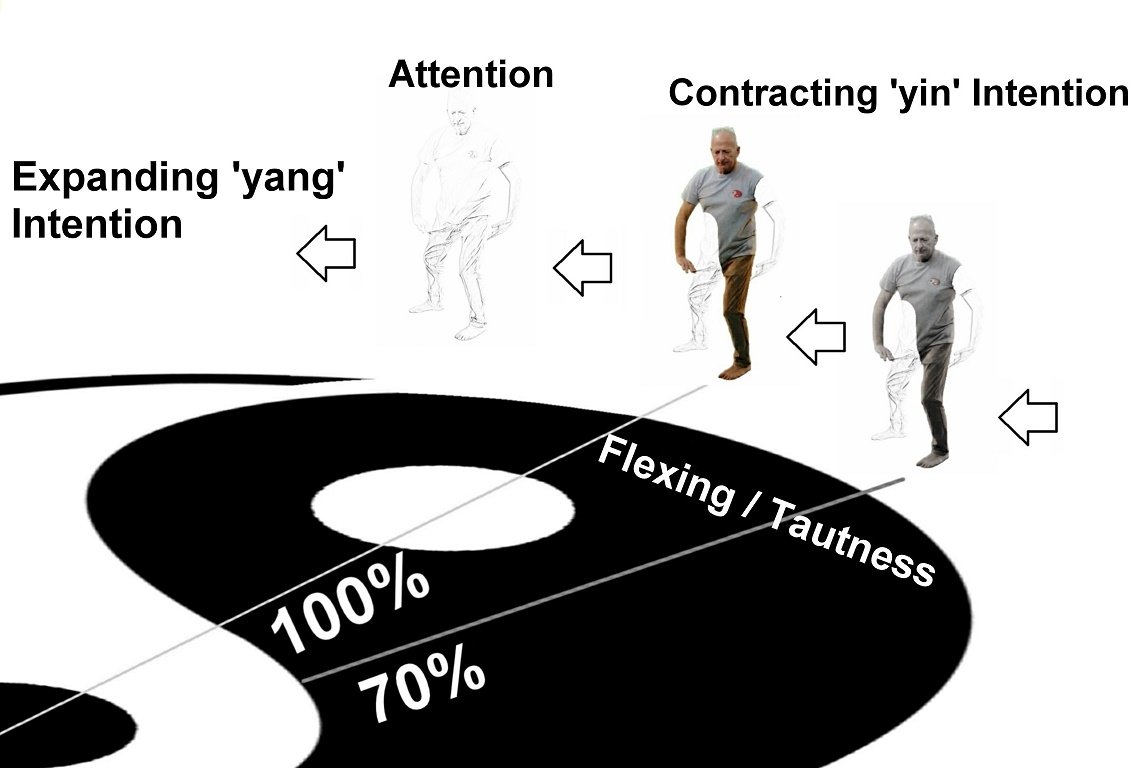Yin Yang in Transition
This article will suggest a practical way of ‘non doing’ during the transition between postures in the Tai Chi form. It replaces intentionally doing the movement with simply paying attention to our inner sensations and feelings. We shift from a human doing to a state of human being.
The blog on Transition discussed Robert Chuckrow (2023) exploration of the transition from Grasp the Sparrows Tail to Roll Back (throw down) as demonstrated by Cheng Man-ch’ing - dòng/dàng (move/swing). Here we will look at the transition from Roll Back (throw down) to Press (double handed push) from a somatic Embodied Tai Chi perspective.
I suggested that the transition includes intentional movement into the ‘yang’ posture Grasps the Sparrows Tail then overshoots being felt as a tighter flex in the body. The practitioner then let’s go of intention and simply pays attention to the flex unwinding allowing it to direct body movement. As the momentum of the flex unwinding ends so the intention of movement towards the ‘yin’ posture Roll Back (throw down) begins. Therefore a ‘yang’ expanding movement into Sparrows Tail becomes more ‘yang’ before swinging back towards the next ‘yin’ contracting posture. This explanation may explain the term ‘momentate’ used in the translation of Cheng Man-ch’ing (1999) explanation of the transition.
Graphically this is replicated in the yin yang symbol. However, what happens in the transition from a ‘yin’ contracting posture? Here Cheng Man-ch’ing suggests this is an important factor that should be applied to all the postures; ‘Apply your energy cyclically from movement to momentum, and back to movement’ (Cheng Man-ch’ing 1999, p.42). I would suggest that the difference between ‘Sparrows Tail’ and Press (throw down) is found within the intention of movement rather than the transition. The intention of movement into ‘Sparrows Tail’ was expanding yang. The posture is correct when we ‘feel’ the flex connecting the whole body. The transition involved increasing that expanding intention tightening the flex.
However, I am reluctant to use the term tightness as this may be interpreted as experiencing tension, something that must be avoided. A term used by Elsa Gindler and discussed by Jacoby seems more appropriate; ‘…become taut: squeeze stones, but not so much that your wrists become stiff’ (Jacoby 2018). Practicing Embodied (somatic) Tai Chi requires you to pay attention to your muscles, tendons and facia flexing but not to the point of tension causing stiffness (Hunt 2023). As we practice Tai Chi in this way we develop greater sensitivity or awareness of our inner body function in movement. Something that may have remained largely unconscious, perhaps perceived after swimming in the cold sea when afterwards our body feels invigorated and more alive; ‘We encounter the same need to remain taut and “present”…’ (Jacoby 2018).
During the transition between postures in the Tai Chi form we let go of the intension to expand into tautness and simply observe or pay attention. The term letting go here is not the same as becoming limp or unresponsive. Intention is replaced by paying attention – being present in our body without the need to do anything. Allow the body to tautness to unflex. This is something that you have to allow your body to do. If you try to make it happen by force of mind / intention the movement seems to become jagged, a ‘discontinuity’ suggested by Cheng Man-ch’ing (1999, p.42).
So the transition in the posture Roll Back (throw down) consists of movement with the ‘yin’ intention of flexing contraction, becomes tauter. Intention is then replaced by simply paying attention to the body’s tautness unflexing, to monentate or ‘swing’ back. As that tautness fades away attention is replaced by the ‘yang’ expanding intention of movement towards the next posture.
The process of transition between postures is subtle, may only be observed by an outside observer as a continuous flowing movement. Yet the Tai Chi practitioner or to give the art its proper name ‘player’ shifts from active doing to passive being then back to active doing. Transition is something to be experienced and is therefore subjective, a personal sensation and feeling. We need to be mindful of this when teaching Tai Chi and when interpreting written and pictorial records.
David Hunt January 11th 2024
References;
Cheng Man-ch’ing (1999) Master Cheng’s New Method of Taichi Ch’uan Self Cultivation, Translated by Mark Hennessy; Blue Snake Books, Berkely CA
Chuckrow Robert (2023) Cheng Man-ch’ing on dòng/dàng (move/swing) in “Roll Back”; video upload dated 2 Dec 2023, https://www.youtube.com/watch?v=PbO1RWltqtY accessed 5th December 2023
Hunt David (2023) Embodied Tai Chi Core Practice; https://embodiedtaichi.org/documents/new-portfolio-under-development , accessed 31st December 2023
Jacoby Heinrich (2018) Beyond ‘Gifted’ and ‘Ungifted’; https://www.kobo.com/GB/en/ebook/beyond-gifted-and-ungifted

